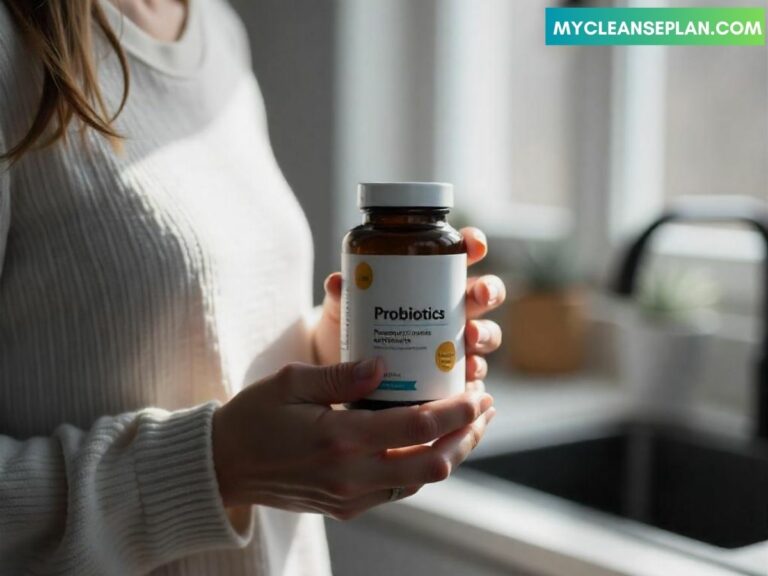How to Safely Reintroduce Food After Gut Reset
Remember that feeling after a holiday, where you overindulged, and your stomach felt… off? Perhaps bloating, gas, or just general discomfort?
That’s when a gut reset comes in handy. But, just as important as the reset itself is safely bringing food back into your diet.
This blog post explores the best ways to carefully reintroduce food after a gut reset, helping you avoid digestive issues and feel your best.
We’ll explore strategies, tips, and common pitfalls to ensure a smooth transition back to enjoying a wide variety of foods.
You will gain a clear path to follow, boosting your confidence and giving you an enjoyable experience after your cleanse.
Key Takeaways
![How to Safely Reintroduce Food After Gut Reset[1]](https://mycleanseplan.com/wp-content/uploads/2025/10/How_to_Safely_Reintroduce_Food_After_Gut_Reset1.jpg)
The Gut Reset Recovery Path
Reintroducing food after a gut reset isn’t about rushing back to your old eating habits. It’s about carefully rebuilding your digestive system’s tolerance and function.
This section will guide you through the initial steps of reintroducing food, focusing on easily digestible options, helping you avoid overwhelming your sensitive gut after your reset.
Initial Reintroduction Strategy: The Gentle Approach
The initial phase of reintroducing food after a gut reset is key for a successful recovery. Start with very simple, easily digestible foods.
This approach minimizes the burden on your digestive system, allowing it to gradually adjust. Overdoing it in the beginning can undo all the hard work of the reset. It is a slow and deliberate process to give your body a chance to adapt and flourish.
- Focus on Simple Foods: Start with gentle foods like cooked vegetables, easily-digested proteins, and small amounts of well-cooked grains.
- Prioritize Thorough Cooking: Cooking food until it is soft is often easier for your digestive system to process.
- Start Small: Introduce one new food every two to three days. This helps you to identify sensitivities.
- Listen to Your Body: Pay close attention to how you feel after eating each new food. Look out for symptoms such as bloating, gas, changes in bowel movements, or skin reactions.
For the first few days, consider starting with bone broth, which is soothing for the gut lining and easily absorbed.
Then slowly incorporate cooked vegetables like carrots, zucchini, or butternut squash. These are soft, gentle, and packed with nutrients. Avoid raw vegetables initially, as they can be harder to digest.
Choosing Your Initial Food Options
Selecting the right foods during the initial reintroduction phase can make a huge difference in your success.
This part will highlight the best food choices for starting the recovery process, giving your body the easiest time possible as it starts to adjust.
- Cooked Vegetables: Cooked carrots, zucchini, and spinach are your friend during this phase. They’re packed with nutrients but gentle on the digestive system. Avoid raw vegetables at first, as they contain more fiber, which can be challenging.
- Easily Digested Proteins: Opt for proteins that are easy to digest, like well-cooked chicken breast or white fish. These choices provide essential nutrients without overworking your gut.
- Well-Cooked Grains: Simple grains like white rice and cooked oats can be introduced in small portions. Avoid whole grains for now, as their high fiber content may be too much for your system.
- Healthy Fats: A small amount of healthy fats, such as avocado or a drizzle of olive oil, can add flavor and nutrients to your meals. These fats are important for overall health and help with nutrient absorption.
Consider starting with small portions of plain, cooked chicken and white rice. Observe how your body reacts.
If you experience no adverse effects, you can gradually add other foods. It’s a process of trial and error, so be patient with yourself.
Early Signs to Monitor for Food Reactions
Understanding the early warning signs of food sensitivities is crucial for a successful food reintroduction.
This section provides a list of things to look out for, helping you identify and address any potential problems quickly.
- Bloating and Gas: These can indicate your body is struggling to digest a particular food. If you notice persistent bloating or excessive gas after eating a new food, it might not be a good fit.
- Changes in Bowel Movements: Diarrhea or constipation can also signal a food sensitivity. Monitor the frequency and consistency of your stools to identify any changes.
- Skin Reactions: Skin rashes, hives, or itching are common signs of food sensitivities. If you develop any skin issues, consider that a certain food might be the culprit.
- Fatigue: Feeling unusually tired or sluggish after eating can be a sign of a food intolerance. Pay attention to your energy levels throughout the day.
- Headaches: Some people experience headaches or migraines after consuming certain foods. Keep a food diary and note any headaches.
If you experience any of these symptoms after introducing a new food, remove that food from your diet for a few days and try again later.
This will help you pinpoint potential triggers. It’s always best to be cautious, especially during this phase.
Advanced Food Reintroduction Tactics
Once you’ve successfully re-introduced basic foods, you can begin to increase the variety and complexity of your meals.
This section introduces more advanced techniques, including how to handle complex foods, identifying hidden sensitivities, and dealing with setbacks.
Expanding Your Diet with More Variety
After a successful start, you can gradually introduce more diverse foods. This stage requires a careful, methodical approach to avoid causing digestive issues.
This guide will help you to increase your food options while still monitoring how your body responds.
- Introduce Foods One at a Time: Continue introducing new foods one at a time, waiting a few days to monitor for any reactions.
- Add More Complex Carbohydrates: Gradually add complex carbohydrates such as sweet potatoes or quinoa.
- Reintroduce Dairy and Gluten Carefully: If you plan to consume these, add small amounts and observe.
- Experiment with Spices: Start using gentle spices such as turmeric and ginger, which have anti-inflammatory properties.
- Add Probiotic-Rich Foods: Introduce probiotic-rich foods such as sauerkraut or kefir, if tolerated, to aid in gut health.
When introducing a new food group, like legumes, start with a small serving of well-cooked lentils or black beans.
Monitor for any signs of discomfort. Avoid combining several new foods at once, as this makes it more difficult to pinpoint any problems.
Identifying and Managing Hidden Food Sensitivities
Sometimes, food sensitivities are not immediately obvious. This section explores strategies to identify less obvious food sensitivities, such as keeping detailed food diaries, and recognizing the more subtle signs of food sensitivities. This will help you to identify any hidden triggers.
- Keep a Detailed Food Diary: Track everything you eat, along with any symptoms you experience. This can help you identify patterns and potential food sensitivities.
- Try Elimination Diets: If you suspect a sensitivity, consider temporarily removing suspected trigger foods from your diet. Then, reintroduce them one at a time to see how you react.
- Work with a Healthcare Professional: A doctor or registered dietitian can help you with food sensitivity testing.
- Consider an IgG Test: An IgG test can identify delayed food sensitivities, which may not show up immediately after you eat something.
For example, you might not immediately link fatigue to a food, but by keeping a detailed food diary, you can identify patterns.
If you suspect a sensitivity to a common food like eggs, try eliminating them for a week and then reintroducing them to see if you feel better without them.
Dealing with Setbacks and Unexpected Reactions
Not every attempt at reintroducing food goes perfectly. This part gives advice on how to respond to setbacks, helping you recover and get back on track. Learn how to address any digestive issues and adjust your plan as needed.
- Don’t Get Discouraged: Setbacks are a normal part of the process. If you have a reaction, don’t give up.
- Return to Easier Foods: If you experience a setback, go back to the foods you tolerate well and give your gut a chance to recover.
- Adjust Your Reintroduction Schedule: Sometimes, you need to slow down the reintroduction process. Don’t be afraid to take it one step at a time.
- Consult a Healthcare Professional: If you experience severe symptoms or are concerned, seek medical advice.
If you experience a setback with a particular food, remove it and wait a few weeks before trying it again. Sometimes, your digestive system simply needs more time to recover. Don’t worry; it is normal to have reactions.
Building a Gut-Friendly Meal Plan
Planning is key to reintroducing food safely. This section offers examples of meal plans that are helpful for the reintroduction process.
These meal plans provide practical examples and recipes to support a gentle approach to your How to Safely Reintroduce Food After Gut Reset.
Example Meal Plans for Early Reintroduction
Here’s a sample meal plan that can help you begin the food reintroduction process. It focuses on gentle, easily digestible foods.
Remember to adjust the quantities and food choices based on your individual needs and tolerance levels.
- Day 1-3:
- Breakfast: Bone broth with a small portion of cooked zucchini.
- Lunch: Plain cooked chicken breast with white rice.
- Dinner: Cooked carrots and white fish.
- Snacks: Small serving of avocado, herbal tea.
- Day 4-6:
- Breakfast: Cooked oats with a drizzle of honey and a side of cooked spinach.
- Lunch: Chicken soup (homemade) with well-cooked noodles and a small portion of chicken.
- Dinner: Baked salmon with steamed asparagus.
- Snacks: A small banana, herbal tea.
- Day 7-9:
- Breakfast: Scrambled eggs (if tolerated) with cooked tomatoes and a sprinkle of herbs.
- Lunch: Turkey meatballs (made with plain ground turkey) over white rice, served with a small portion of green beans.
- Dinner: Vegetable stir-fry (cooked carrots, broccoli, and zucchini) with a small portion of tofu.
- Snacks: A small serving of cooked sweet potato, herbal tea.
Remember, the goal is to be patient and listen to your body. These are general guidelines, so change them to align with your personal needs.
Essential Ingredients for a Gut-Friendly Diet
Certain ingredients can greatly support gut health. This part highlights food groups that support the healing of your gut, including foods that promote good bacteria, reduce inflammation, and provide essential nutrients for a smooth return to normal.
- Probiotic-Rich Foods: Consider adding probiotic-rich foods, such as sauerkraut, if tolerated. These foods contain beneficial bacteria that can support a healthy gut.
- Prebiotic-Rich Foods: Incorporate prebiotic foods, like onions and garlic, which feed the good bacteria in your gut. These are usually added later in the reintroduction phase.
- Fiber-Rich Vegetables: Including fiber-rich vegetables like broccoli, spinach, and carrots is essential for overall gut health.
- Healthy Fats: Consume healthy fats, such as olive oil and avocado, to reduce inflammation and support nutrient absorption.
- Lean Proteins: Opt for lean proteins like chicken and fish, which are easy on the digestive system and provide essential amino acids.
Make sure you thoroughly wash your vegetables to eliminate any surface dirt. Use healthy fats to help the absorption of fat-soluble vitamins such as Vitamin A, D, E, and K.
Cooking Techniques to Improve Digestibility
How you prepare your food has a big impact on digestion. This section gives some tips for cooking to make the digestive process easier.
Explore cooking methods to soften food and make it easier for your gut to handle after your How to Safely Reintroduce Food After Gut Reset.
- Steaming: Steaming vegetables helps to soften them, while keeping the nutrients.
- Braising: Braising meat makes it tender and breaks down some of the tough fibers.
- Slow Cooking: Slow cooking is excellent for making meat tender and also gentle on the digestive system.
- Pureeing: Pureeing fruits and vegetables can make them easier to digest, particularly in the initial phases.
- Blending: Blending soups and smoothies allows for easy digestion.
For vegetables, steaming or boiling them until soft is ideal, as this breaks down the fibers, making them easier to digest.
Avoid frying, as this can add extra fats and make digestion more difficult. Simple cooking methods are often best.
Maintaining Gut Health After Reintroduction
The goal isn’t only to reintroduce foods but also to preserve gut health over the long term. This section provides advice for sustained wellness. Learn the habits and lifestyle choices that can support a healthy gut for the long term.
Long-Term Habits for a Healthy Gut
To support your gut health, you need to create lasting habits. This list provides advice for maintaining a thriving gut. Focus on integrating these behaviors into your daily routine to promote long-term digestive well-being.
- Eat a Varied Diet: Eating a diverse range of foods supports a rich gut microbiome.
- Manage Stress: Stress can negatively impact gut health. Practice stress-reducing techniques, like meditation or yoga.
- Get Enough Sleep: Sleep is essential for overall health, including gut health. Aim for 7-9 hours of quality sleep.
- Stay Hydrated: Drinking enough water helps with digestion and keeps your gut functioning smoothly.
- Consider Probiotic Supplements: Discuss probiotic supplements with your healthcare provider to see if they’re right for you.
Adding fermented foods to your diet can also promote a thriving microbiome. Make sure that you are also sleeping and staying hydrated for gut support.
Foods and Drinks to Prioritize
Certain foods and drinks are particularly beneficial for maintaining gut health. This is a guide to which foods and drinks to embrace. Incorporating these items into your diet will give you a healthy gut.
- Fiber-Rich Foods: Foods like fruits, vegetables, and whole grains promote healthy digestion.
- Probiotic-Rich Foods: Consume probiotic-rich foods, such as yogurt or kefir, to support the good bacteria in your gut.
- Omega-3 Fatty Acids: Consume foods rich in omega-3 fatty acids, such as salmon, to reduce inflammation.
- Hydrating Beverages: Drink plenty of water and herbal teas to support digestion and overall health.
Include plenty of colorful fruits and vegetables in your diet for a variety of nutrients and fiber. Always consume foods and drinks in moderation.
Lifestyle Factors Affecting Gut Health
Beyond diet, lifestyle factors play an important role in the gut. This segment covers how your daily habits can positively influence gut health. This guidance helps you create a healthy balance that supports your gut.
- Regular Exercise: Exercise can improve digestion and reduce stress, promoting a healthy gut. Aim for at least 30 minutes of moderate exercise most days.
- Limit Alcohol and Caffeine: These substances can irritate the gut. Try to consume them in moderation or avoid them altogether.
- Avoid Processed Foods: Highly processed foods can harm your gut health. Stick to whole, unprocessed foods as much as possible.
- Manage Medications: Some medications can disrupt the gut microbiome. Discuss your medications with your doctor to understand any potential effects.
Consider going for a walk, or doing some light stretches, to improve digestion. If you’re stressed, focus on relaxation techniques.
FAQ Of How to Safely Reintroduce Food After Gut Reset
What’s the best way to start reintroducing food after a gut reset?
A: Start with gentle, easily digestible foods like cooked vegetables, plain chicken breast, and white rice, one at a time, to help your system adjust.
How long should I wait between introducing new foods?
A: Wait 2-3 days between each new food to see how your body reacts.
What should I do if I experience symptoms when reintroducing food?
A: Stop eating the new food and go back to the foods you tolerate well. Give your gut a chance to recover. If symptoms are severe, consult a healthcare provider.
Can I eat gluten and dairy after a gut reset?
A: Reintroduce these with caution. Start with small portions and observe how your body reacts. You may find you tolerate them better after your reset, or you may need to reduce or eliminate them.
How long does the whole reintroduction process take?
A: The reintroduction process can vary depending on your body, but it typically takes several weeks to a few months.
Final Thoughts
Successfully reintroducing food after a How to Safely Reintroduce Food After Gut Reset is a gradual process.
Focus on easy-to-digest foods and slowly add new items, one at a time. Pay close attention to your body’s signals, and don’t hesitate to adjust your plan based on how you feel.
Remember to incorporate habits that sustain a healthy gut, such as a balanced diet, proper sleep, and stress management.
Be patient with yourself. By listening to your body and making informed choices, you can rebuild a robust and happy gut!

![Microbial Signature Index Unveiling Disease Prediction Capabilities[1]](https://mycleanseplan.com/wp-content/uploads/2025/10/Microbial_Signature_Index__Unveiling_Disease_Prediction_Capabilities1-768x448.jpg)


![Prebiotic Fiber Trends Popular Types of Fiber on the Rise[1]](https://mycleanseplan.com/wp-content/uploads/2025/10/Prebiotic_Fiber_Trends__Popular_Types_of_Fiber_on_the_Rise1-768x448.jpg)
![The Business of Gut Health Market Trends, Consumer Behavior & Opportunities[1]](https://mycleanseplan.com/wp-content/uploads/2025/10/The_Business_of_Gut_Health__Market_Trends_Consumer_Behavior__Opportunities1-768x448.jpg)
![How to Use Elimination Diets to Identify Gut Triggers[1]](https://mycleanseplan.com/wp-content/uploads/2025/10/How_to_Use_Elimination_Diets_to_Identify_Gut_Triggers1-768x448.jpg)